Exploring the Parks: Brand-New Sáttítla Highlands National Monument
Air Date: Week of February 14, 2025
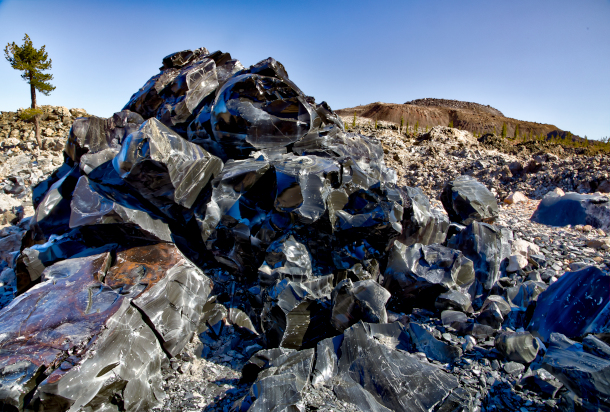
Sattitla means “obsidian place” in Achumawi, a language spoken by the Pit River people. (Photo: courtesy of Protect Sattitla Campaign)
In his last days in office President Biden designated the new Sáttítla Highlands National Monument in northern California. Hosts Paloma Beltran and Jenni Doering discuss the otherworldly volcanic landscape and its importance to local tribes.
Transcript
BELTRAN: The Trump administration is once again considering redrawing the boundaries of national monuments. In his first term President Trump tried to drastically shrink Bears Ears and Grand Staircase Escalante in Utah but President Biden restored those boundaries. And just before leaving office, Joe Biden used his authority under the Antiquities Act to declare two new national monuments in California. It’s not clear if they too will be targeted for reduction by the Trump administration. But Jenni I had the honor of talking to some of the community leaders and tribal members who advocated for these recent monument designations.
DOERING: Yeah Paloma just the other week you shared with us the story behind the Chuckwalla National Monument. A beautiful desert landscape in SoCal Southern California that holds deep cultural and spiritual significance for several tribal communities.
BELTRAN: Yeah and that monument is located near Palm Desert in the Coachella Valley.
And if you take I-5 North from Chuckwalla and drive about 12 hours, you’ll end up in the Sáttítla Highlands National Monument. It’s also stunning but in a totally different way.
DOERING: Ooh! Okay, tell me more, Paloma.
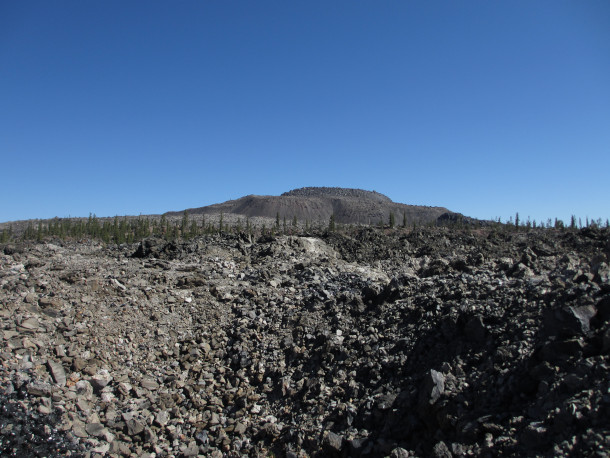
Glass Mountain is a spectacular, nearly treeless area made up of volcanic rock ago from an eruption that took place around a thousand years ago. (Photo: Petr Brož, Wikimedia Commons, CC BY-SA 3.0)
BELTRAN: Yeah, I’d be happy to. So Sáttítla means “obsidian place” in Achjumawi, a language spoken by the eleven bands of the Atsuwegi nation, also known as the Pit River people. The monument surrounds the Medicine Lake Highlands, where there’s a massive and dormant Medicine Lake Volcano not far from Mount Shasta. This area is a spiritual place for many of the indigenous tribes of northern California. And I talked to Brandy McDaniels, a Pit River Tribal spokesperson to learn more.
McDANIELS: Sáttítla is a very sacred place for the Pit River people. It's the actual location of our creation narrative. And these are described as by our people, as our church. These are holy lands. So in that way, it's very sacred. It's been touched by Hey-wee-see, it's God. We have been actively using these tribal cultural landscapes since time immemorial, since time began, since the first twinkling of light.
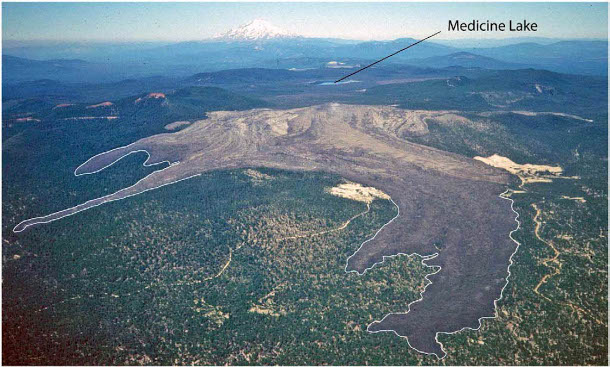
Aerial view west across the upper part of Medicine Lake Volcano toward Mount Shasta, with the caldera lake labeled in the distance. (Photo: Donnelly-Nolan, USGS.gov, Public Domain)
DOERING: Wow, sounds like a special place. And so how does this monument status give protections to Sáttítla?
BELTRAN: Well, the volcanic origins of the area make it attractive to geothermal developers. Geothermal energy is considered a renewable resource, because earth’s core continuously produces heat. It can involve the injection of hydrofluoric and hydrochloric acids that can release harmful chemicals into the air and water. This northern part of California is often referred to as the headwaters of the state since its volcanic rock naturally purifies water. So safeguarding Sáttítla protects clean water for millions of people as well as farms and ecosystems throughout the state.
DOERING: And Paloma, what does this volcanic landscape actually look like?
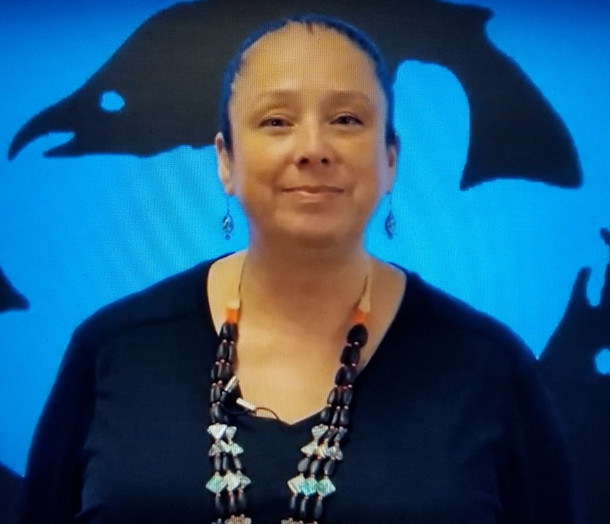
Brandy McDaniels is the spokesperson for the Pit River tribe. (Photo courtesy of Brandy McDaniels)
BELTRAN: Well, I asked Brandy to describe it for us and it truly sounds magical.
McDANIELS: If you were going up that way, first you would see Ako, which is also known as Mount Shasta, a very spiritually important place for us. And you would see forested areas. You would come in, and then you would encounter unique lava flows, caves. There's a lot of people that like to explore the volcanic landscape of the area, yeah, just stunning vistas and views.
BELTRAN: And, you know, that geologic history is incredible. Nick Joslin is the Forest and Watershed Program Manager at the Mount Shasta Bioregional Ecology Center, and he said that fiery past makes for some stunning features.
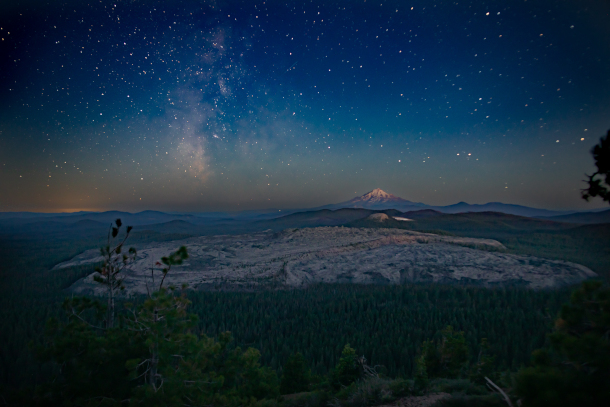
Medicine Lake Volcano, a shield volcano, is the largest volcano in the Cascades by volume. (Photo: courtesy of Bob Wick)
JOSLIN: Sáttítla and another sort of sister volcano called Newberry are shield volcanoes, so they are lower elevation, but broader and flatter shaped and due to their large size and as far as mass is concerned, those two are sort of the two largest, by mass, Cascade volcanoes. And so from a distance, it looks like a really gentle slope. And when you get up onto the actual volcano, the striking features are very recent lava flows.
DOERING: Oh! Wait, I’ve actually been to that sister volcano he mentioned, Newberry in southern Oregon. And you can hike through the obsidian flow there, it’s so cool.
BELTRAN: Yeah, and the obsidian at these volcanoes has been an important source of material for stone tools for thousands of years. Just be aware, the general public is not allowed to collect obsidian here. So, while some people like the Pit River tribes are used to this volcanic landscape, Nick says that for many folks it feels like being on another planet.
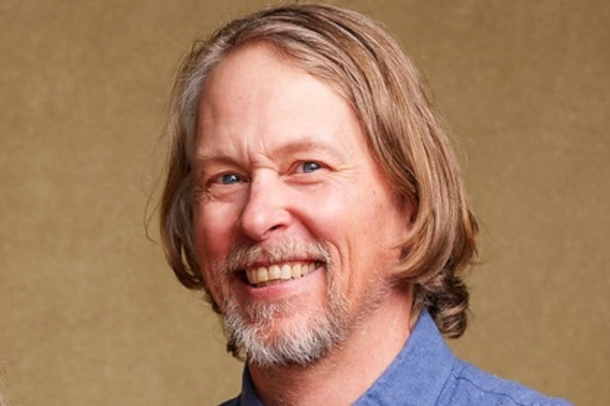
Nick Joslin is the Forest and Watershed Watch and Community Fire Resiliency Program Manager at Mount Shasta Bioregional Ecology Center. (Photo by Nick Joslin)
JOSLIN: So you'll be driving along the road through dense forest and then pop out into just a stark black landscape with almost nothing growing on it. And the top of the caldera is a large lake called Medicine Lake, and off in the distance, you can see a large obsidian flow that's like black glass. It just kind of shimmers in the sun. It's really kind of almost like a Martian landscape in places.
DOERING: Whoa, sounds out of this world. And by the way, Nick said there are very recent lava flows, so… how recent are we talking?
BELTRAN: He means ‘recent’ in geologic time. It’s dormant today and the last time lava flowed at Sáttítla was around 1,000 years ago. That said, it could become active again, so the US Geological Survey keeps a close eye on it.
DOERING: OK, good to know! [LAUGHS] And Paloma what sorts of animals call this area home?
BELTRAN: Well, there are tons of animals typical of a Cascade Range habitat like bears, mountain lions, wolves, eagles, and other raptors. There are also some old growth forests that house spotted owls.
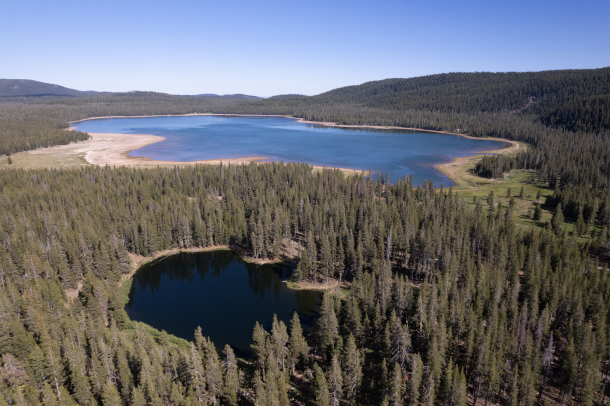
Medicine Lake is amongst the many lakes inside the Sattitla Highlands National Monument in northern California. (Photo: courtesy of Bob Wick)
DOERING: Oh, cool. So what should people know before visiting Sáttítla Highlands National Monument?
BELTRAN: It’s high country, so Nick said the best time to visit is after the snow melts, between late spring and early fall. It’s also pretty remote, and that can be a good thing.
JOSLIN: You are going far off the beaten path if you're going to go to this monument. You lose cell phone reception part way up the mountain, and it's worth it to sort of check out and have that ability to disconnect. It has some of the darkest skies in the lower 48 and it's a notably quiet place. So you're far enough away from light, you're far enough away from noise that you get an experience that is very hard to find these days.
DOERING: Oh man, that’s priceless in this day and age.
BELTRAN: I totally agree, Jenni.
DOERING: Well, what a gem! I’m definitely adding Sáttítla Highlands National Monument to my 2025 bucket list. Thank you so much, Paloma.
BELTRAN: Thank you, Jenni.
Links
Learn more about the Sáttítla Highlands National Monument
The Conservation Alliance | “National Monument: Save Sáttítla – Medicine Lake Highlands”
Living on Earth wants to hear from you!
Living on Earth
62 Calef Highway, Suite 212
Lee, NH 03861
Telephone: 617-287-4121
E-mail: comments@loe.org
Newsletter [Click here]
Donate to Living on Earth!
Living on Earth is an independent media program and relies entirely on contributions from listeners and institutions supporting public service. Please donate now to preserve an independent environmental voice.
NewsletterLiving on Earth offers a weekly delivery of the show's rundown to your mailbox. Sign up for our newsletter today!
 Sailors For The Sea: Be the change you want to sea.
Sailors For The Sea: Be the change you want to sea.
 The Grantham Foundation for the Protection of the Environment: Committed to protecting and improving the health of the global environment.
The Grantham Foundation for the Protection of the Environment: Committed to protecting and improving the health of the global environment.
 Contribute to Living on Earth and receive, as our gift to you, an archival print of one of Mark Seth Lender's extraordinary wildlife photographs. Follow the link to see Mark's current collection of photographs.
Contribute to Living on Earth and receive, as our gift to you, an archival print of one of Mark Seth Lender's extraordinary wildlife photographs. Follow the link to see Mark's current collection of photographs.
 Buy a signed copy of Mark Seth Lender's book Smeagull the Seagull & support Living on Earth
Buy a signed copy of Mark Seth Lender's book Smeagull the Seagull & support Living on Earth

